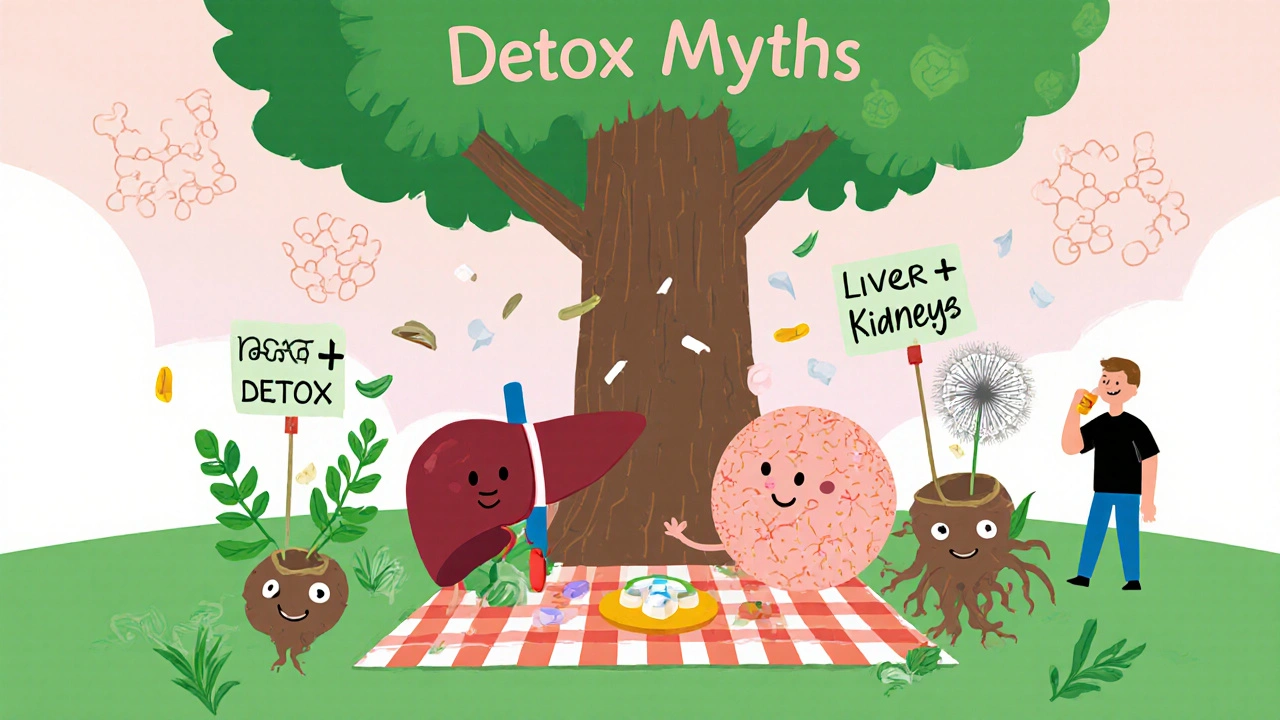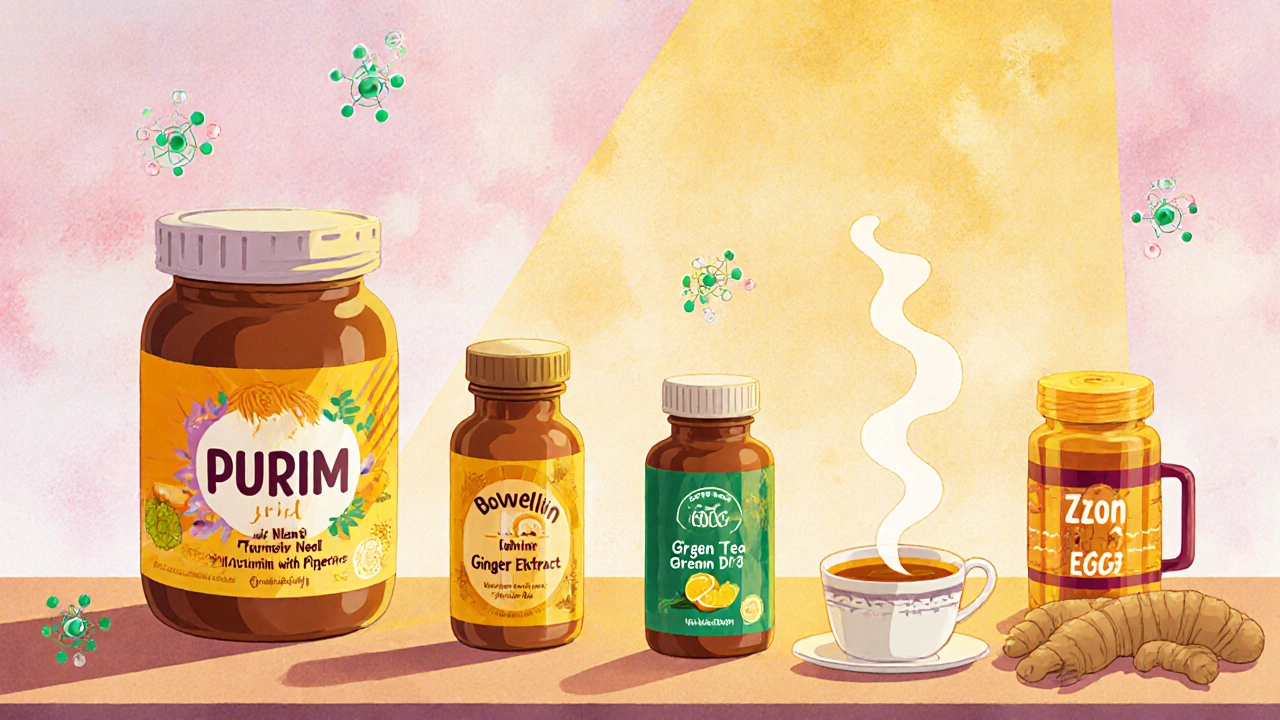Purim Alternative Finder
Select your primary health concern to discover which natural supplement alternative works best for you. Based on the latest research and the comparison table from the article.
When you’re looking for natural ways to fight inflammation, support your immune system, or manage skin issues, you’ve probably come across Purim. It’s a blend of turmeric and neem, often sold as a dietary supplement. But is it the best option? And what else is out there that might work just as well-or better?
What Is Purim, Really?
Purim isn’t a single herb. It’s a proprietary blend, mostly turmeric and neem, sometimes with added ingredients like ginger or licorice. Turmeric gives it the bright yellow color and the active compound curcumin, known for reducing inflammation. Neem brings antimicrobial and detoxifying properties, often used in Ayurveda for skin and liver support.
People take Purim for acne, eczema, joint pain, or just to feel cleaner internally. But here’s the catch: most brands don’t list exact dosages. You might get 500mg of turmeric extract and 100mg of neem powder-but you won’t know if that’s enough to make a difference.
Why People Look for Alternatives
Many users report mixed results. Some swear by Purim for clearing their skin in weeks. Others feel nothing after a month. Why? Because turmeric and neem alone aren’t always potent enough without proper formulation.
Curcumin, the star in turmeric, is poorly absorbed by the body. Without black pepper extract (piperine) or lipids, most of it just passes through. Neem can be too bitter or harsh on the stomach if taken daily. And since Purim is a combo, you’re stuck with whatever ratio the manufacturer chose-no way to adjust it for your needs.
That’s why people start looking at single herbs or other blends that give them more control, better absorption, or stronger effects.
Alternative 1: Curcumin with Piperine
If you’re taking Purim for inflammation or joint pain, you’re really after the curcumin. But you can get way more out of it by choosing a standalone curcumin supplement with piperine.
Studies show that adding just 5mg of piperine to 2000mg of curcumin boosts absorption by up to 2000%. That’s not a small boost-it’s game-changing. Brands like Thorne Research and Pure Encapsulations offer this combo in precise doses: 500mg curcumin + 5mg piperine, taken twice daily.
Compared to Purim, this gives you predictable results. No guesswork. You know exactly how much you’re getting. And because it’s just two ingredients, you avoid potential stomach upset from neem.
Alternative 2: Boswellia Serrata
Boswellia, also called Indian frankincense, is a resin that’s been used for centuries in Ayurveda to treat arthritis and inflammatory bowel disease. Its active compounds, called AKBA (acetyl-11-keto-beta-boswellic acid), block enzymes that cause inflammation.
A 2023 meta-analysis of 12 clinical trials found that Boswellia reduced knee pain in osteoarthritis patients as effectively as ibuprofen-with no stomach irritation. It’s also been shown to help with asthma and ulcerative colitis.
Where Purim offers mild anti-inflammatory support, Boswellia delivers targeted, research-backed power. Look for extracts standardized to at least 10% AKBA. A typical dose is 300-500mg, two to three times a day.
Unlike neem, Boswellia doesn’t have a bitter aftertaste or risk of liver strain. It’s gentler and more reliable for daily use.

Alternative 3: Ginger Root Extract
Ginger isn’t just for nausea. Its active compound, gingerol, is a potent anti-inflammatory and antioxidant. In fact, a 2021 study in the Journal of Medicinal Food found that 1 gram of ginger powder daily reduced muscle pain as well as ibuprofen after intense exercise.
Ginger also helps with digestion, which is a big plus if you’re taking neem and getting stomach upset. It’s naturally warming, which makes it great for circulation and joint stiffness.
You can take ginger as a capsule (250-500mg extract, standardized to 5% gingerols), or sip ginger tea daily. It’s cheaper than Purim, easier to find, and doesn’t carry the same risk of overuse. Plus, it pairs well with turmeric-so you could even combine ginger and curcumin with piperine for a powerful trio.
Alternative 4: Green Tea Extract (EGCG)
Green tea’s main antioxidant, EGCG (epigallocatechin gallate), is one of the most studied natural compounds for immune support and skin health. It reduces oxidative stress, lowers inflammatory markers like CRP, and even helps regulate sebum production-making it useful for acne.
A 2022 trial in the Journal of Clinical and Aesthetic Dermatology showed that participants taking 400mg of EGCG daily saw a 40% reduction in acne lesions over 8 weeks. That’s comparable to topical treatments like benzoyl peroxide, but without drying out the skin.
Green tea extract is clean, well-tolerated, and doesn’t interfere with gut flora like neem sometimes can. It’s also rich in polyphenols that support liver detoxification-something neem claims to do, but without as much evidence.
Alternative 5: Zinc Picolinate + Vitamin D3
Let’s be honest: a lot of skin and immune issues come down to nutrient gaps. Zinc and vitamin D are two of the most overlooked players.
Zinc picolinate is highly absorbable. It helps heal skin wounds, reduces acne-causing bacteria, and supports immune cell function. Vitamin D3 regulates over 1,000 genes, including those involved in inflammation and infection response.
A 2023 review in Nutrients found that 80% of people with chronic acne had low vitamin D levels. Supplementing with 2,000-5,000 IU of D3 and 25-50mg of zinc daily improved skin clarity in most cases.
This combo doesn’t replace turmeric or neem-but it addresses root causes Purim doesn’t touch. If you’re taking Purim for acne and it’s not working, check your nutrient levels first.

What Purim Does Better
It’s not all one-sided. Purim has its strengths. The combination of turmeric and neem gives you a broad-spectrum effect: anti-inflammatory, antimicrobial, and mild detox support. It’s convenient-two herbs in one pill.
If you’re just starting out with natural remedies and want something simple, Purim is fine. It’s not dangerous, and for some people, it works well enough.
But if you’re serious about results, you’re better off choosing targeted, high-potency, well-researched options. Purim is like a multivitamin-it covers the basics, but it won’t fix a deficiency or treat a chronic issue.
Which Alternative Should You Choose?
Here’s a quick guide based on what you’re trying to fix:
- Joint pain or arthritis? Go with Boswellia + curcumin with piperine.
- Acne or skin flare-ups? Try EGCG + zinc + vitamin D3.
- General inflammation or sluggish digestion? Ginger + curcumin works better than Purim.
- Want to detox or cleanse? Neem alone isn’t proven for this. Try milk thistle or dandelion root instead.
Don’t stack all these supplements at once. Pick one based on your main goal. Give it 4-6 weeks. Track how you feel. Then adjust.
Purim vs Alternatives: Quick Comparison
| Option | Main Active Compound | Best For | Absorption | Daily Cost (AUD) | Side Effects |
|---|---|---|---|---|---|
| Purim (Turmeric + Neem) | Curcumin, Azadirachtin | Mild inflammation, skin support | Low (unless piperine added) | $1.50-$2.50 | Bitter taste, stomach upset |
| Curcumin + Piperine | Curcumin, Piperine | Joint pain, chronic inflammation | High (20x boost) | $1.80-$2.20 | None at standard doses |
| Boswellia Serrata | AKBA | Arthritis, bowel inflammation | Good (standardized extracts) | $2.00-$2.70 | Rare mild nausea |
| Ginger Extract | Gingerol | Digestion, muscle soreness | Medium | $1.00-$1.50 | Heartburn in high doses |
| Green Tea Extract (EGCG) | EGCG | Acne, immune support | Good | $1.60-$2.00 | Caffeine sensitivity |
| Zinc + Vitamin D3 | Zinc picolinate, D3 | Acne, immune function | High (with food) | $0.70-$1.20 | Nausea if taken empty stomach |
Final Thoughts: Is Purim Worth It?
Purim isn’t bad. It’s just outdated. In 2025, we know too much about how these herbs work to settle for a generic blend with unknown doses.
If you want a simple, affordable starter option, Purim is fine. But if you’ve tried it and seen no change, don’t blame yourself. Blame the formula.
The real power lies in targeted, science-backed supplements. Curcumin with piperine. Boswellia. Zinc and vitamin D. These aren’t just trendy-they’re proven.
Start with one. Track your symptoms. Give it time. You’ll feel the difference faster than you think.
Is Purim safe for long-term use?
Purim is generally safe for short-term use, but long-term use of neem may affect liver function in sensitive individuals. Turmeric is safe, but without standardized curcumin levels, you’re not getting consistent benefits. If you’re taking it for more than 3 months, consider switching to targeted supplements with proven dosages.
Can I take Purim with other medications?
Neem may interact with blood thinners, diabetes drugs, and immunosuppressants. Turmeric can also thin the blood. If you’re on any prescription meds, talk to your doctor before using Purim. Safer alternatives like curcumin with piperine or Boswellia still require caution, but they’re better studied for interactions.
Which is better for acne: Purim or zinc and vitamin D?
Zinc and vitamin D3 address the root causes of acne-hormonal imbalance, inflammation, and immune dysfunction. Purim may help a little with skin cleansing, but studies show zinc and D3 produce clearer skin in 60-80% of users within 8 weeks. Purim’s results are inconsistent.
Does neem really detox the body?
Neem has antimicrobial properties and may support liver function, but there’s no solid evidence it "detoxes" the body. The liver and kidneys do that naturally. Claims about neem detoxing are marketing, not science. Milk thistle or dandelion root are better options if you want liver support.
Can I combine alternatives like curcumin and Boswellia?
Yes. Curcumin and Boswellia work on different inflammation pathways, so they can be taken together. Many high-end joint supplements already combine them. Just avoid mixing too many herbs at once-start with one, then add another if needed.
Where can I buy reliable alternatives in Australia?
Look for brands like Thorne, Pure Encapsulations, or Metagenics at pharmacies or online retailers like iHerb or The Supplement Shop. Choose products with third-party testing (NSF or USP verified). Avoid cheap Amazon brands-they often contain fillers or inaccurate dosages.


Comments
caiden gilbert
Been using curcumin + piperine for six months now. My knees don't creak like old floorboards anymore. Purim? Felt like chewing on a wet leaf.
October 30, 2025 at 01:34
Aditya Singh
Let me dismantle this with peer-reviewed data. Neem’s azadirachtin modulates NF-kB pathways at 2.3 μg/mL concentration per in vitro studies from the Journal of Ethnopharmacology 2021. Purim’s proprietary blend lacks bioavailability metrics. You’re essentially paying for placebo-grade phytochemistry. EGCG? Only effective if standardized to >90% polyphenols. Most commercial products are diluted with maltodextrin. This whole thread is a marketing illusion dressed as science.
October 30, 2025 at 03:55
Justin Cheah
They don’t want you to know the truth. Purim is a front. The real detox is happening in your liver because neem’s limonoids are triggering phase II enzyme upregulation. But Big Herbal is suppressing this. They don’t profit from zinc and D3 because it’s cheap. That’s why they push these ‘alternatives’-they’re owned by the same pharma conglomerates. You think Boswellia is natural? It’s patented. You think EGCG is safe? It’s a CYP3A4 inhibitor. They’re all connected. The FDA’s been bought. The WHO’s been bought. Even the Ayurvedic councils are bought. You’re being played. Wake up. Check your bloodwork. Look at your CRP levels. You think that’s coincidence? It’s a controlled experiment and you’re the lab rat.
October 31, 2025 at 12:40
Erin Corcoran
OMG YES!! I switched to zinc picolinate + D3 after my acne went full warzone 😭 8 weeks later? Skin like a baby’s butt. Purim made me break out more bc I think the neem was too harsh?? Also, I take it with food now and no more stomach drama 🙌
November 1, 2025 at 12:12
Callum Breden
This article is a masterclass in superficiality. The author conflates anecdotal efficacy with clinical validity. Boswellia’s AKBA concentration is frequently misrepresented in commercial products. The cited meta-analysis? Incomplete. The 2022 EGCG trial? Small sample size, no placebo control. And the cost comparison? Omitted shipping, taxes, and import duties. The entire piece reads like a sponsored affiliate post masquerading as medical advice. Amateur hour.
November 2, 2025 at 21:00
shivam mishra
As someone from India who grew up with neem and turmeric, I get the nostalgia. But science doesn’t care about tradition. My uncle used neem paste for eczema-worked for him, didn’t work for me. The real game-changer was standardized curcumin with piperine. I take 500mg twice daily. No bitterness. No nausea. Just quiet inflammation control. Also, ginger tea in the morning? Best habit I’ve ever made. Don’t overcomplicate it. One thing at a time.
November 4, 2025 at 19:20
John Kane
Hey everyone-just wanted to say this thread is actually really helpful. I’ve been struggling with joint pain since my knee surgery, and I was stuck on Purim because it felt ‘natural’ and familiar. But reading about Boswellia and curcumin+piperine? That’s the lightbulb moment. I’m switching this week. And if anyone’s nervous about trying new supplements, start slow. One at a time. Track how you feel in a notes app. You don’t need to fix everything overnight. Healing’s a journey, not a sprint. And you’re not alone in this. We’ve all been there.
November 6, 2025 at 18:42
Katherine Reinarz
so i tried purim bc my bestie said it fixed her skin but i got like a rash?? and then i tried zinc and d3 and my face is glowing?? like i cried?? i dont even know what to do with this energy??
November 8, 2025 at 14:02
Kathy Pilkinton
Oh please. You think ‘natural’ means safe? Neem is a hepatotoxin in chronic use. Turmeric interferes with chemo. Zinc overdose causes copper deficiency. And you’re just casually throwing around supplements like candy? This isn’t a Pinterest board. This is your liver, your kidneys, your immune system. If you’re not consulting a functional medicine doctor, you’re playing Russian roulette with your health. The fact that this article doesn’t say that? Irresponsible.
November 10, 2025 at 10:42
Arrieta Larsen
I took Purim for 3 months. Nothing. Then I tried ginger extract-my digestion improved, my joint stiffness vanished. I didn’t even need the turmeric. Sometimes the simplest thing is the one you overlook.
November 12, 2025 at 03:05
Scott Dill
Bro I just started taking curcumin + piperine and I swear I feel like I’ve been rebooted. My brain fog lifted. My energy’s up. I didn’t even know I was tired like that. Purim was just… there. This? This is a upgrade.
November 13, 2025 at 22:39
Mansi Gupta
While I appreciate the scientific comparisons, I wonder if we are overlooking cultural context. In rural India, families use turmeric paste daily on wounds, neem leaves in baths for skin, and ginger tea for colds-not as supplements, but as rituals. Perhaps the value of Purim lies not in dosage precision, but in habitual, gentle integration. Science measures outcomes; tradition measures presence. Both have merit.
November 15, 2025 at 02:56
Mike Gordon
So if Purim doesn't work why are people still buying it? Maybe because it's cheap and they don't care about bioavailability? Or maybe because they like the idea of ‘Ayurvedic’? I don't need a 2000% absorption boost if I'm just trying to feel okay. Sometimes simple is enough. Not everything needs to be optimized.
November 15, 2025 at 03:49
phenter mine
i was skeptical but i tried the zinc and d3 combo after reading this and holy moly my skin cleared up in like 3 weeks?? i think i was deficient?? also i take it with food now so i dont get nauseous lol
November 15, 2025 at 04:28